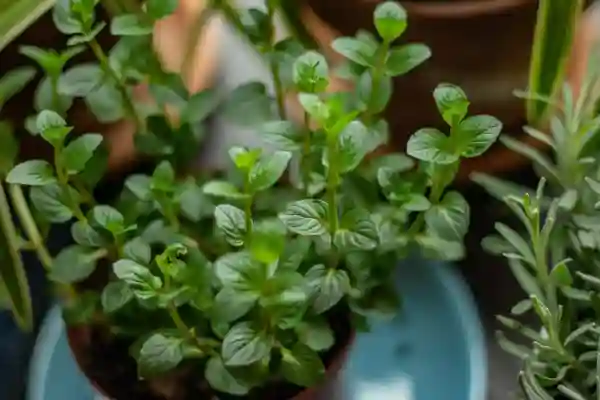

5 easy herbs to grow at home
Growing your own fresh herbs at home is easier than you think, whether you have a garden, balcony, window box or a light windowsill. If you've ever been interested in growing your own fresh herbs, now is the perfect time to start. Not only does it save money on the weekly shop, but you'll be doing your bit to help the planet too. As your home-grown herbs won’t have as far to travel to get to your kitchen, you'll have cut the food miles of your meal, not to mention any packaging too. If you grow organically, you'll also be helping the planet by reducing the use of pesticides. Not to mention benefitting from all the valuable phytonutrients found in freshly grown herbs!
If you're feeling green-fingered, we'll show you the best and easiest herbs to grow at home, plus our top tips on how to grow herbs indoors and outdoors.
First, choose your favourite herbs to grow – here are 5 of our favourites.
Before you start, it's important to consider which herbs you want to grow for your kitchen garden. If you're unsure, start off by making a list of the herbs you use already. Then, consider herbs that you haven't tried yet but think would make a good addition to your kitchen based on your favourite recipes. If you love Italian dishes, basil or thyme are commonly used herbs and are some of the easiest herbs to grow at home in pots. If you're a fan of herbal teas, chamomile, mint and fennel are fantastic healthy herbs for delicious teas.
Basil: This lush green annual herb makes wonderful fresh pesto sauce. This easy to germinate herb needs lots of sunshine, and will thrive on a light filled windowsill or outside in a sunny, sheltered spot in free-draining rich soil.
Thyme: Not just a delicious herb in the kitchen, thyme is also an important herb for respiratory and digestive health. It is included in our Breathe In blend for this reason. A woody perennial (comes back each year) from the Mediterranean, thyme thrives in full sunshine and poor soils. It's an essential herb in any herb garden.
Chamomile: One of the most widely used herbs for relaxing globally, this annual herb thrives in a sunny environment with well-drained soil. It grows to around 60cm producing an abundance of sweet-smelling daisy like flowers which can be harvested 2-3 months from sowing.
Mint: Mint is a wonderfully cooling perennial herb which offers digestive support as well as tasting delicious. It can thrive in full sun or partial shade but needs regular watering through spring to autumn to stay happy.
Fennel: It’s loved by gardeners and highly respected by herbalists for its calming effects on digestion. It is delicious in recipes but also as a herbal tea. It can grow quite tall, so this herb is best grown outdoors in a large window box or flower bed with 30cm in between plants.
When it comes to sourcing seeds for these herbs, you can buy collections of ‘Kitchen herbs’ from your local garden centre or online. These offer around 20 seeds each which is all you need to get going and give some plants away. We love the Herbal Kitchen Garden – from Earthsong Seeds set up by Pukka’s co-founder, Sebastian Pole. Or get together with some friends and swap.
How to grow herbs from seeds:
To sow your herb seeds in a pot, sprinkle the seeds onto a layer of fine peat free seed compost. The best time to sow seeds is generally spring or early summer. Then lightly cover with a thin layer of compost. Some seeds may germinate faster than others so keep the soil moist for 2-4 weeks. Do remember to label the sown seeds, as it can be difficult to recall which herb is in which pot (even if you think you will remember, most seedlings look very similar!) And be patient - some seeds take 4 weeks to germinate, such as thyme, whereas others like basil will appear quicker. When you do have lots of seedlings, you can eat any excess as nutritious ‘microgreens’. For example if you do sow a whole packet of basil, you can save the best seedlings to grow on and eat the rest as ‘microgreens’ in a salad.
Don’t want to start your kitchen garden with seeds?
Don’t want to start with seeds? Another way to have fresh herbs is to buy small plants from the garden centre that are already established to grow on in your kitchen garden. Or an even easier way is to buy fresh potted herbs from the supermarket but then split them apart when you get home. Supermarket herbs tend to die after a couple of weeks as there are so many young plants crammed into a small pot that they soon run out of nutrients. But if you carefully separate out the small plants and give each its own pot of compost, you can grow supermarket herbs at home and they will last all summer. This technique works well for basil, thyme, and mint from our list of favourites. It will also work for rosemary, chives and parsley.
Find the perfect location for your herbs.
When it comes to setting up your kitchen herb garden, location is very important. Choosing the right place will help your plants thrive and you'll be able to get the most out of them. Consider the conditions that your chosen herbs grow in best and scout out the ideal spot in your garden. It may be the case that it's best to split your kitchen garden into two separate areas with varying degrees of direct sunlight if you're growing a variety of herbs that thrive in different conditions. So basil likes warm and sunny, while mint prefers more damp conditions, but still needs some sunshine.
Don't worry if you don't have a garden, as you don't have to miss out. In fact, many herbs thrive indoors. For Herbs that like direct sunlight, such as basil or chamomile, will grow in a clear space on your windowsill. And for plants which need less sun, such as mint, place them somewhere that still gets some sun each day.
If your herbs grow too big for the windowsill, you may want to move them outside to a window box. Not only is this a great way to get them in the direct sunlight, but herbs are bee-friendly too. The key advantage to having fresh herbs growing in your kitchen, or just outside on a windowsill is that they are close to hand, and you will remember to add them to recipes.
Find eco-friendly ways to look after your herbs.
Growing your own herbs is already an environmentally conscious thing to do, but you can help the planet even more by finding eco-friendly ways to care for your herbs. You’ll need a good multi-purpose compost to provide nutrients, but make sure to get a sustainable one that doesn’t contain peat. Another tip is to save the water you've used for cooking to water your herb garden. The nutrients in the cooking water act as a fertilizer, which helps promote natural nutrient storage in the soil and encourages it to retain moisture for longer. Make sure to avoid using cooking water that has been salted, as this can make the plant dehydrated. You can also collect rainwater to use on your kitchen herbs.
Try to opt for environmentally friendly plant pots as well. Rather than buying new plastic ones, buy high-quality pots made from a sturdy material, such as ceramic, so they will last for years to come. Coir pots are another great planet-friendly option. Not only are they made out of a natural material, coconut fibre, but they're fully biodegradable too. You may also want to consider recycling items you already have to turn them into plant pots, such as tea boxes, plastic containers or tins. Make sure to clean them thoroughly and drill in drainage holes to keep your plants healthy.
Make the most of your ingredients.
Herbs are incredibly versatile and many can be used in a wide range of food and drink recipes. Fresh basil leaves can be used for pasta, pizza and soups, or to create your own pesto. Thyme leaves all work particularly well in soups, stews and casseroles. One of our favourite ways to use home-grown herbs is in a fresh herb pesto, blending fresh basil, fennel leaves and a few sprigs of thyme with olive oil and lightly toasted pine nuts.
Many herbs work perfectly with hot and cold drinks too. You can create a delicious mint tea with just a few fresh mint leaves. And to give your favourite teas a twist, try adding some herbs in your teapot alongside the teabag. Fresh fennel works perfectly with a chamomile tea or mint tea for example.
You can use your herbs fresh or dry some to use through the winter months. To do this, place them out on a rack and keep in a dark, warm and well-ventilated area for 12-24 hours, or until crisp and dry.
Growing your own herbs is a great way to add delicious flavour to your favourite recipes and herbal teas, whilst doing good for the planet too. Bunches of your own freshly grown herbs also make an ideal gift for friends and family. If you use the tips above, you can easily grow a variety of fresh organic herbs from your own home.
